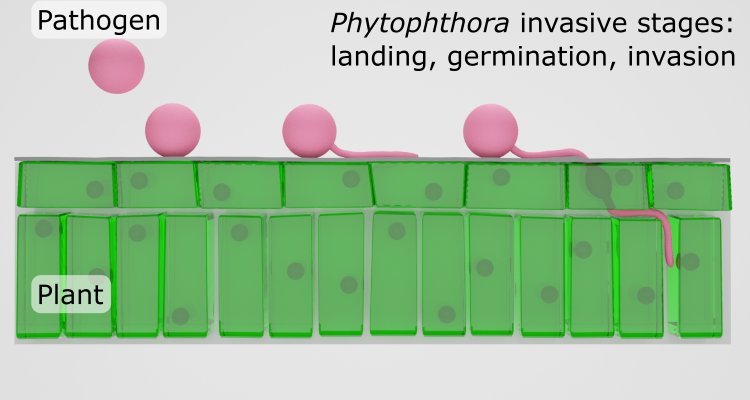
Project
Studying Phytophthora’s invasive mechanobiology
Phytophthora species are severe plant pathogens, invading and degrading their hosts plants aggressively. Phytophthora species are parasites of important foodcrops, when left unchecked caused the Irish potato famine that killed and displaced millions. Even today, these plant pathogens need to be contained and understood to ensure new outbreaks can be subdued effectively and durably. We aims to understand how invasive hyphae of Phytophthora species mechanically interact with their plant hosts to regulate invasion.
Background
Phytophthora species are a broad family of plant pathogens, of which Phytophthora infestans is the most famous member. P. infestans was the causal agent of the Irish potato blight, causing a massive famine over a century ago. This famine was so severe that only recently the population of Ireland is starting to recover to levels seen before the famine.
However, the phytophthora family is much larger, and consist of nearly 200 members, the majority of which are plant pathogens that are fungus-like (but in a completely different part of the tree of life). Starting from a diseased plant, the mycelium produces highly mobile spores. In wet environments, like a later summer rain, spores are dispersed and spread to new healthy host plants. The process of how the spores enter their new healthy hosts is unknown but is mediated through hyphae entering the leaves upon which it has landed.
Project description
We aim understand how the invasive hyphae apply their forces onto plant leaves and elucidate how this process is governed. Although this objective sounds simple, the small size of the hyphae (a few microns, requiring high magnification microscopy) makes studying this directly very difficult.
We use model substrates on which species like to grow, to which we can add force-sensing capabilities. Combining both force-sensing and the ability track genetic activity enables us to elucidate the invasion mechanism of these invasive hyphae.
Results
We have had major interesting results, fully elucidating the mechanism of invasion which we have coined the “Naifu” mechanism. In this mechanism both adhesion and indentive forces play their own major roles, the disruption of which is key to stopping surface invasion on both model and plant hosts. Application of these strategies on leaf material shows major decrease in invasion as well.
There are of course many questions still left: how is the actin network, which is generally not very stiff/strong, able to withstand such large forces? What is the mechanism behind this incredibly quick and responsive regulation? What proteins are involved? We hope you would like to help us find answers to these questions!
Publications
-
A slicing mechanism facilitates host entry by plant-pathogenic Phytophthora
Nature Microbiology (2021), Volume: 6, Issue: 8 - ISSN 2058-5276 - p. 1000-1006. -
An actin mechanostat ensures hyphal tip sharpness in Phytophthora infestans to achieve host penetration
Science Advances (2022), Volume: 8, Issue: 23 - ISSN 2375-2548 - p. eabo0875-eabo0875. -
Molecular sensors reveal the mechano-chemical response of Phytophthora infestans walls and membranes to mechanical and chemical stress
The Cell Surface (2022), Volume: 8 - ISSN 2468-2330
Contact
Do you have a question about the molecular compass, or would you like to join us as a student researcher? Please contact us.